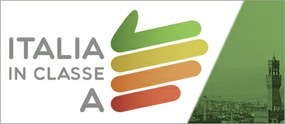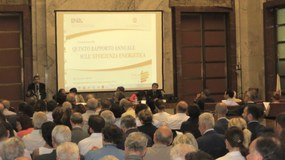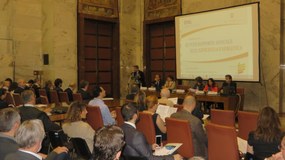Energy: Ever more Italians going green with 28 billion expenditure for energy-efficent homes
7/7/2016
With energy efficiency 3 billion euro savings on oil and gas import.
Italy comes in at the top for energy efficiency: in less than ten years Italian households have spent nearly 28 billion euro (+12% in one year) to reduce waste and make their homes more energy efficient, with 2.5 million energy efficiency interventions between 2007 and 2015. A green trend supporting a supply chain of an average of 50thousand jobs yearly.
 Overall, in the period 2005-20015, savings from energy efficiency measures were close to 10 Mtep (1) yearly, avoiding 26 million tonn CO2 emissions and a 3 billion euro expenditure to import fossil fuels.
Overall, in the period 2005-20015, savings from energy efficiency measures were close to 10 Mtep (1) yearly, avoiding 26 million tonn CO2 emissions and a 3 billion euro expenditure to import fossil fuels.
That’s what emerges from the V Energy Efficiency Report (RAEE), presented by ENEA at the Ministry of the Economic Development, a monitoring, analysis and evaluation tool in support to the policies adopted for this sector. A picture underscoring the Italian leading position in Europe with a lower energy intensity level compared to the EU average (-18%), which is very positive since the lower the energy intensity level of a Country the higher its energy efficiency.
The Report highlights the fact that Italy has reached 32% of the savings energy target for the year 2020 set under the 2014 National Energy Efficiency Plan: among the energy efficiency tools that have proven very effective are the white certificates, the tax deductions for energy efficiency improvements and the so called “ecobonuses”, used mostly for thermal insulation of buildings, replacement of window frames and installation of more energy efficient heating systems.
“Domestic energy efficiency policies have met significant objectives, although there are still obstacles to overcome and significant room for improvement for increasing our competitive advantage“, Federico Testa, President of ENEA, pointed out. “ENEA-he added- is on the forefront in ensuring that energy efficiency can provide further benefits for reducing the energy bills of households, companies and the PA through concrete measures and the introduction of innovative technologies. Energy efficiency is a great opportunity for the sectors involved, such as education, cultural heritage and agri-food but also for boosting strategical sectors like the building sector”, Testa went on. “An important sector, for which so far little has been done is the 60’s and 70’s condos, with poor energy efficiency. It’s necesssary to define incentives giving a chance to the occupants that don’t have the economical means to make green choices” Testa concluded.
 The V Annual Report focuses extensively on the energy efficiency renovation of the building stock, a sector accounting for nearly 40% of the final EU consumption. “Italy has paid considerable attention to the energy performance of buildings although there still are factors hindering the full exploitation of the energy potential available. A more extensive and effective information and streamlined access to financial tools are the key factors to making the significant investments necessary to reach the objectives set a european level, get off the ground.”- Roberto Moneta, Head of the ENEA Technical Unit for Energy Efficiency, said.
The V Annual Report focuses extensively on the energy efficiency renovation of the building stock, a sector accounting for nearly 40% of the final EU consumption. “Italy has paid considerable attention to the energy performance of buildings although there still are factors hindering the full exploitation of the energy potential available. A more extensive and effective information and streamlined access to financial tools are the key factors to making the significant investments necessary to reach the objectives set a european level, get off the ground.”- Roberto Moneta, Head of the ENEA Technical Unit for Energy Efficiency, said.
The report confirms that also in 2014 the energy demand dropped to a total value of 151 Mtep (+3.4 compared to the previous year) in line with the negative trend started in 2010. As regards final consumptions, the civil sector accounts for the largest share (37.1%), followed by transportation (33.3%) and industry (21.3%).
In 2014 final consumption of the industrial sector was 25.7 Mtep, dropping 2.4% compared to the previous year. The industrial sector was particularly affected by the economic crisis, so much so that in the period 2017-2014 consumption decreased by 31.5%. In 2014 energy-intensive sectors accounted for over 60% of the final consumption.
 With the Legislative Decree 102/2014 transposing the Directive 2012/27/UE, the energy diagnosis for enterprises was introduced: in 2016 ENEA has received 10.823 diagnoses, 50% from the manufacturing sector and 15% from the commercial sector.
With the Legislative Decree 102/2014 transposing the Directive 2012/27/UE, the energy diagnosis for enterprises was introduced: in 2016 ENEA has received 10.823 diagnoses, 50% from the manufacturing sector and 15% from the commercial sector.
In 2014, also the residential sector recorded a significant decrease in consumptions (25.5 Mtep), with a 15% drop compared to 2013. In the non-residential sector, after a steady growth over the previous twenty years, slowed down only by the economic crisis, consumptions decreased to 19Mtep, a 6.7% drop.
The share of fossil fuels in transportation, 99% in 2007, lowered to to 95% in 2014, due to a reduction in petrol and diesel fuel consumption and an increase in bio-fuels.
As regional energy performances are concerned, the Report highlights that 60% of the energy efficiency projects was completed with the 2007-2013 Structural Funds. Furthermore, in the period 2014-2015, the energy renovation interventions in the PA, either completed or undergoing, covered a total area of 855.235 square meters. The energy efficiency interventions carried out with funds from the 2014-2020 POR-FESR amount to 2.4 billion euro.
The report devotes one chapter to energy efficiency communication, with a special reference to the Three-Year Information and Training Program envisaged by the DLGS 102/2014 with the aim of introducing to SMEs, state employees, families, students and banks the tools, advantages and importance of energy efficiency and create a diffuse culture of efficiency and sustainability of energy and environmental resources.
The National Campaign “ Italy in classe A” was launched to increase awareness among the public and the media on energy efficiency through information, training and a journalist award.
In the first year the campaign will focus on the PA, given the fact that the over 13thousand public buildings consume around 4.3 TWh energy/year with a total expenditure of 664 million euro that could be cut by 40% through energy efficiency measures.
